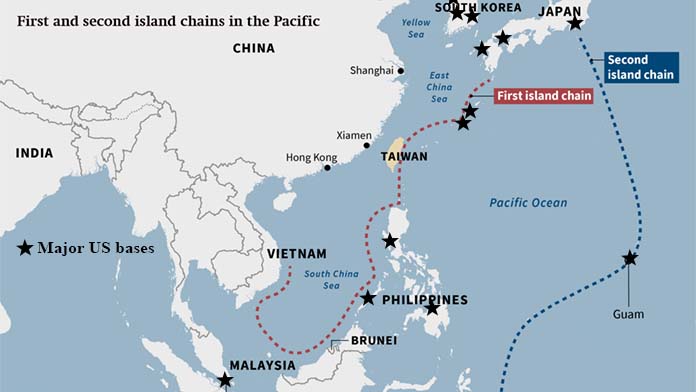
 HOW MANY THEN?! DO YOU OFFER ANYTHING MORE THAN REPUBLICRAT APOLOGIST BOILERPLATE?! UGH!!
HOW MANY THEN?! DO YOU OFFER ANYTHING MORE THAN REPUBLICRAT APOLOGIST BOILERPLATE?! UGH!!
The US is the biggest bully in the Pacific, with rings of military bases blocking and threatening China, writes Tom Orsag.
solidarity.net.au
"..Active duty
Most of these bases remain active today. In 2021, the US defence magazine
19FortyFive wrote that, “The U.S. Indo-Pacific Command has some 375,000 military and civilian personnel working across the Asian Pacific.”
The US maintains 56,000 active duty military personnel at more than 80 bases and other facilities across Japan, the most in any one country outside the US. About half are based in Okinawa.
Through the Cold War, the US pointed nuclear weapons at China from bases in Japan, Taiwan and South Korea.
Nuclear weapons were moved from Okinawa to the Iwakuni base near Hiroshima in 1966. When the US ambassador to Japan, Edwin O. Reischauer, learned of their presence, which was a violation of the treaty with Japan, he told the US State Department that he would resign and go public with the information if they were not removed within 90 days. The weapons were removed shortly thereafter.
Improvements in ballistic missile technology and nuclear-armed submarines mean the US no longer needs these nuclear weapons bases. Today there are still 5000 marines and two air force squadrons stationed at Iwakuni.
The US ran Okinawa via an appointed US High Commissioner until May 1972, with local people having no say, after which it was “returned” to Japan. But US troops stayed.
Power projection
Another 30,000 US personnel are based in South Korea, which the US has never left following the Korean War in the 1950s.
Camp Humphreys, southwest of Seoul in South Korea, is the largest US overseas military base in the world with more than 500 buildings. It is just 540 kilometres from the city of Dalian on the Chinese mainland, with a population of more than seven million people. That is the same distance as driving between Sydney and Wodonga on the Victorian border.
The US Army calls the base “the largest power projection platform in the Pacific”.
With the addition of the nearby Osan air base and the Kusan air base another 116 kilometres south, the US can project power both north into North Korea and west into China.
In the Philippines the US still has access to five airbases, following the closure of its large naval base at Subic Bay and the Clark air base in the early 1990s. The
Financial Times reported in January that the country is planning to “allow US forces to pre-position weapons and other supplies on five more bases in addition”.
Taiwan is another key link in the chain. The US seeks to guarantee Taiwan’s de facto independence from China through arms sales and military support. A procession of US politicians including Nancy Pelosi have staged provocative visits in the last year to declare their “solidarity” with Taiwan and US President Joe Biden has repeatedly said the US would defend it against any Chinese invasion.
The US also has an agreement with Singapore that allows it to use naval and air bases there, which sit in a vital strategic chokepoint on the straits of Malacca at the entry to the South China Sea....

